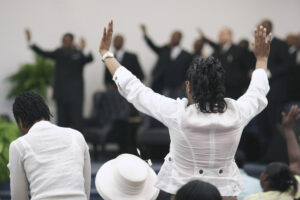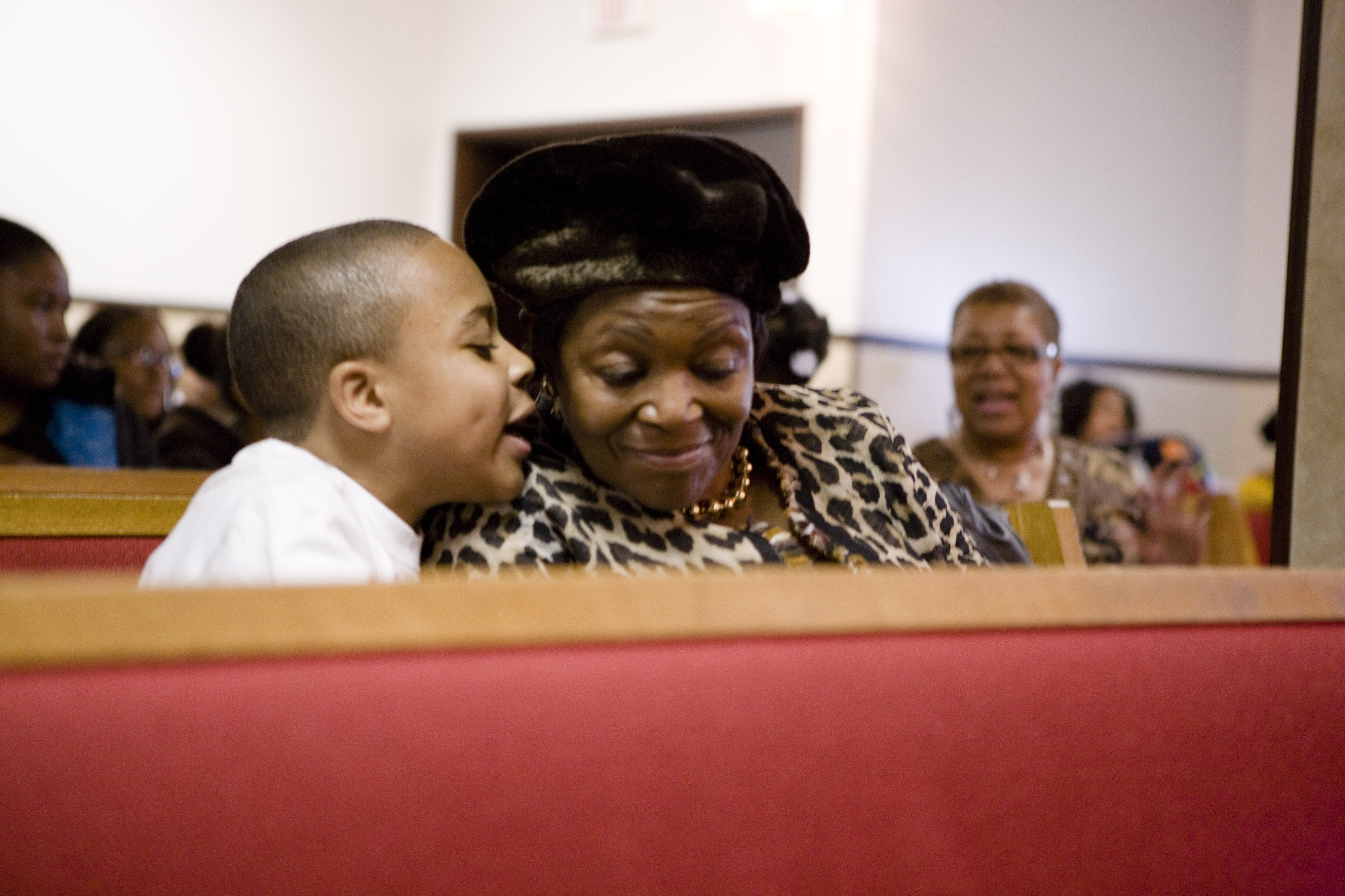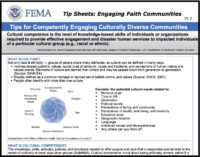In this tip sheet, you will discover foundational information to help you interact with Black Church Protestant leaders. It is part of a set of tools and training for FEMA to help disaster response professionals engage with faith communities. Much of the information also can help students, researchers, government agencies, non-profits and businesses learn about and develop relationships with communities. Click here for the PDF version of this tip sheet.
Religion Called: Protestantism (or by denominational name, e.g. African Methodist Episcopal (A.M.E.)
Adherents Consider Themselves: Christian and are called Christians (or denomination’s name, e.g. Baptist)
House of Worship: Church (or Cathedral, Tabernacle, or Temple)
First Point of Contact: Pastor and governing committee
Religious Leader: Minister/pastor (or honorific title such as Archbishop, Prophet, Prophetess)
Spoken Direct Address: Use “Reverend” or “Pastor” depending on denomination
Physical Interaction: Handshake and/or hugging generally O.K. across genders
HOUSE OF WORSHIP
Many denominations of the Black Church call their worship site a “church.” It is common for some church buildings to have a steeple topped with a cross. Some Protestants meet in borrowed space (e.g. a school auditorium) or use a commercial space. Congregations can be small storefront churches or large-scale campuses with multiple buildings. Avoid assumptions based on church size and location as these may not correlate to the level of influence of the congregation’s religious leader.
RELIGIOUS LEADERS
Ordained/Commissioned/Licensed Leaders
- Common terms for leaders include: minister or pastor. The Methodist Episcopal denominations and Church of God in Christ also have deacons, elders, and bishops.
- Honorific titles, designated by seniority, are used by some denominations (e.g. Archbishop, Minister, Prophet, Prophetess).
- Levels of responsibility and authority conferred by these titles may not equate to similar titles used in other denominations.
- Some Black Churches use the term “the Reverend” as a noun meaning “clergyperson”; some use it only as an adjective.
- In some traditions, deacons are clergy; in others, it is a temporary elected office.
- Some Black Church denominations have no gender qualifications for leadership roles or participation in worship. A few limit leadership roles to men while women may be clergy in others.
Lay Leaders
- Includes lay governing bodies such as a board of deacons, elders, mothers of the church, parish council, or vestry.
- In some denominations, the influential “First Lady” is the wife of the Senior Pastor and may be called “Lady [Last Name]”.
POINTS OF CONTACT
- Local: Local congregations are usually led by a pastor. Many local congregations (even those of denominations with a robust regional or national governing structure) are self-governing. Often, local governance is in the hands of an elected committee (see “Lay Leaders”). First point of contact at local level should be both pastor and governing committee.
- Regional: Varies by denomination (usually a Bishop or judicatory body).
- National: Varies by denomination (usually a national judicatory body).
NVOAD MEMBERSHIP AND CORE CAPABILITIES IN DISASTER
National Voluntary Organizations Active in Disaster (NVOAD) is a nonprofit, nonpartisan, membership based organization that serves as the forum where organizations share knowledge and resources throughout the disaster cycle. FEMA DSA team members should check with their VAL to determine whether local or regional VOADs exist in their operational area. National VOAD members include:
- Church World Service—includes membership from Black Church denominations
- Episcopal Relief and Development (ERD)
- National Baptist Convention U.S.A.
- United Methodist Committee on Relief (UMCOR)
- The Church of God in Christ also has a disaster relief arm known as COGIC Charities (not a NVOAD member)
Also consider whether megachurches (over 2000 members) are located in the affected area as they are likely to be active in disaster response/recovery efforts. They may have significant capabilities and/or disaster-related needs.
ETIQUETTE QUICK TIPS
Greeting
When introducing yourself to a religious leader, use formal religious or honorific titles unless instructed otherwise. Avoid assumptions based on a religious leader’s title or the name of a house of worship. Significance of these may vary from similar titles used in other denominations. Congregations members of baptized age may greet each other as “brother” or “sister.”
Physical Interaction
Shaking hands and/or hugging is common in most Black Church denominations. In certain conservative denominations it may not be readily accepted for members of the opposite sex to shake hands or embrace.
Other
When entering a Black Church, shoes are generally left on but men should remove hats or caps. Other than this general practice, traditions around dress codes for both sanctuary spaces and office spaces vary dramatically according to culture and geographical region of the country. In many historically Black Church congregations, visitors would be expected to use formal “Sunday best” dress for worship services. This may include business suits for men and dresses or skirts for women.
Ask before participating in worship services. If not a member, do not participate in an altar call, taking communion, or in a healing. Ushers can help with customs, dress, and etiquette.
GOVERNANCE / JUDICATORY
Denominations generally fall into two categories: 1) Denominational with hierarchical authority (African Methodist Episcopal Church, Church of God in Christ) and 2) Part of a national association or network (e.g. Baptist). Many are fully independent. It may be difficult to determine—if unsure, ask.
MEETING LOGISTICS AND SCHEDULING
Scheduling and Holidays
Avoid meetings on Sundays as it is the Sabbath for most Protestants. Some denominations may schedule a full day of activities on this day. Be aware that many Protestant religious leaders take Monday as their day off. Holidays include:
- Christmas: a celebration of the birth of Jesus as God incarnate.
- Holy Week: leads up to Easter; begins with Palm Sunday (recalling Jesus’ return to Jerusalem); includes Maundy Thursday (recalling Jesus’ institution of the practice of Holy Communion during his last meal with his disciples) and Good Friday (recalling Jesus’ crucifixion).
- Easter Season: the most important season in the Christian year celebrating the resurrection of Jesus from the dead.
- Pentecost: commemorating the receipt of the Holy Spirit by the nascent Christian community, fifty days after Jesus’ Resurrection. This holiday is recognized by many and is a major celebration for some.
- All Protestants follow the same liturgical calendar, with varying levels of observance for the seasons of Advent and Lent.
- Some congregations celebrate “Homecoming” (in late summer, usually).
- Some Protestants also observe other days related to their denominational history.
- Thanksgiving Day (a U.S. national holiday) is celebrated as a religious holiday by some Protestant churches.
Food
Few general restrictions or requirements; check with individual leaders. Some denominations do take very seriously laws of fasting and abstinence, refraining from eating meat on certain days and limiting the quantity of food on other days. During the season of Lent, some denominations are required to abstain from eating meat on Fridays, but may eat fish.
Logistics
Many Black Church congregations are becoming “commuter congregations,” meaning that congregants may not necessarily live in the neighborhoods surrounding their church. While this should be taken into consideration when scheduling meetings, it can also be a useful characteristic for expanding post-disaster outreach into the additional neighborhoods where congregants
live. Immigration of Latinos, primarily from Central America and Mexico, has also meant some houses of worship serve both African-American and Spanish-speaking congregations.
DRESS
- Generally, leaders wear clothing prescribed by their denomination or a variety of other ecclesiastical clothes based on personal choice or understanding of their denomination’s historical preferences. This may include clothing as varied as a black shirt and white clerical collar, a suit and tie, a purple cassock, or clothes similar to lay members.
- Lay congregation members often dress formally or semi-formally for worship services.
ABOUT HISTORICALLY BLACK PROTESTANT DENOMINATIONS
Historically, the Black Church in the United States has been composed of seven denominations: the African Methodist Episcopal Church; the African Methodist Episcopal Zion Church; the Christian Methodist Episcopal Church; the Church of God in Christ; and three National Baptist Conventions which convene Black Baptist congregations: the National Baptist Convention of America, the National Baptist Convention, USA, Inc., and the Progressive National Baptist Convention, Inc. Black denominations also include Southern Missionary Baptists and non-denominational churches. Most denominations originated as
a result of racial segregation in Protestant denominations, but have since grown and evolved exponentially. Today, it is increasingly problematic to classify the Black Church as a single entity composed primarily of African-American congregants.
Ongoing immigration from East and West Africa, Central America, and the Caribbean has transformed many congregations that were traditionally African-American into mixed congregations including first and second generation immigrants. Basic tenets are similar to white evangelical denominations:
- Protestantism is characterized by assertion of a personal relationship with God through Christ, study of the Bible by laypersons, freedom of conscience on many matters, and a variety in worship styles.
- Jesus of Nazareth is considered (by many) God Incarnate. The birth, ministry, death, and resurrection of Jesus are definitive.
- Protestants are Trinitarian in their understanding of the nature of God.
- The Holy Spirit is important to all Protestants, but receives more emphasis from some than from others.



